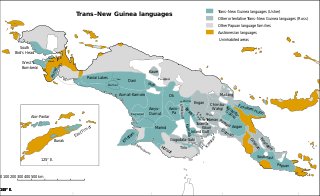
Trans–New Guinea (TNG) is an extensive family of Papuan languages spoken on the island of New Guinea and neighboring islands, a region corresponding to the country Papua New Guinea as well as parts of Indonesia.
An interrogative word or question word is a function word used to ask a question, such as what, which, when, where, who, whom, whose, why, whether and how. They are sometimes called wh-words, because in English most of them start with wh-. They may be used in both direct questions and in indirect questions. In English and various other languages the same forms are also used as relative pronouns in certain relative clauses and certain adverb clauses. It can also be used as a modal, since question words are more likely to appear in modal sentences, like
The Ramu–Lower Sepika.k.a.Lower Sepik–Ramu languages are a proposed family of about 35 Papuan languages spoken in the Ramu and Sepik river basins of northern Papua New Guinea. These languages tend to have simple phonologies, with few consonants or vowels and usually no tones.
Sulka is a language isolate of New Britain, Papua New Guinea. In 1991, there were 2,500 speakers in eastern Pomio District, East New Britain Province. Villages include Guma in East Pomio Rural LLG. With such a low population of speakers, this language is considered to be endangered. Sulka speakers had originally migrated to East New Britain from New Ireland.
Warembori is a moribund language spoken by about 600 people in Warembori village, Mamberamo Hilir District, Mamberamo Raya Regency, located around river mouths on the north coast of Papua, Indonesia.
Usku, or Afra, is a nearly extinct and poorly documented Papuan language spoken by 20 or more people, mostly adults, in Usku village, Senggi District, Keerom Regency, Papua, Indonesia.
Ughele is an Oceanic language spoken by about 1200 people on Rendova Island, located in the Western Province of the Solomon Islands.

The Angan or Kratke Range languages are a family of the Trans–New Guinea languages in the classification of Malcolm Ross. The Angan languages are clearly valid as a family. They were first identified as such by J. Lloyd and A. Healey in 1968; Wurm (1975) classified them as Trans–New Guinea. Glottolog treats Angan as a separate or unclassified family, ignoring further evidence.

The Nias language is an Austronesian language spoken on Nias Island and the Batu Islands off the west coast of Sumatra in Indonesia. It is known as Li Niha by its native speakers. It belongs to the Northwest Sumatra–Barrier Islands subgroup which also includes Mentawai and the Batak languages. It had about 770,000 speakers in 2000. There are three main dialects: northern, central and southern. It is an open-syllable language, which means there are no syllable-final consonants.
Kembra is a South Pauwasi language spoken in Western New Guinea by some twenty persons in Kiambra village, Kaisenar District, Keerom Regency. It is used by between 20% and 60% of the ethnic population and is no longer passed down to children.
Uyghur is a Turkic language spoken mostly in the west of China.

Sumuri or Sumeri is a language spoken in Sumuri District, Teluk Bintuni Regency on the Bomberai Peninsula by about a thousand people.
The Orya–Tor languages are a family of just over a dozen Papuan languages spoken in Western New Guinea, Indonesia.
Yoke is a poorly documented language spoken by about 200 people in the north of Papua, Indonesia. The name is also spelled Yoki, Yauke, and it is also known as Bitovondo. It was spoken in a single village in the interior until the government relocated a third of the population to a new village, Mantarbori, on the coast. In the late 19th century, a word list of "Pauwi" was collected by Robidé van der Aa at Lake Rombebai, where the Yoke say they migrated from; this is transparently Yoke, apart from some words which do not appear in the modern language but are found in related Warembori.
Mawes was a Papuan language of Indonesia.
Kambota.k.a.Ap Ma, is a Keram language of Papua New Guinea. Compared to its nearest relative, Ambakich, Kambot drops the first segment from polysyllabic words.
Bandial (Banjaal), or Eegima (Eegimaa), is a Jola language of the Casamance region of Senegal. The three dialects, Affiniam, Bandial proper, and Elun are divergent, on the border between dialects and distinct languages.
Kelon, or Klon, is a Papuan language of the western tip of Alor Island in the Alor archipelago of East Nusa Tenggara, Indonesia.

Toʼabaita, also known as Toqabaqita, Toʼambaita, Malu and Maluʼu, is a language spoken by the people living at the north-western tip of Malaita Island, of South Eastern Solomon Islands. Toʼabaita is an Austronesian language.
Lengo or informally known as "Doku" is an Oceanic language spoken on the island of Guadalcanal. It belongs to the Southeast Solomonic language family.






